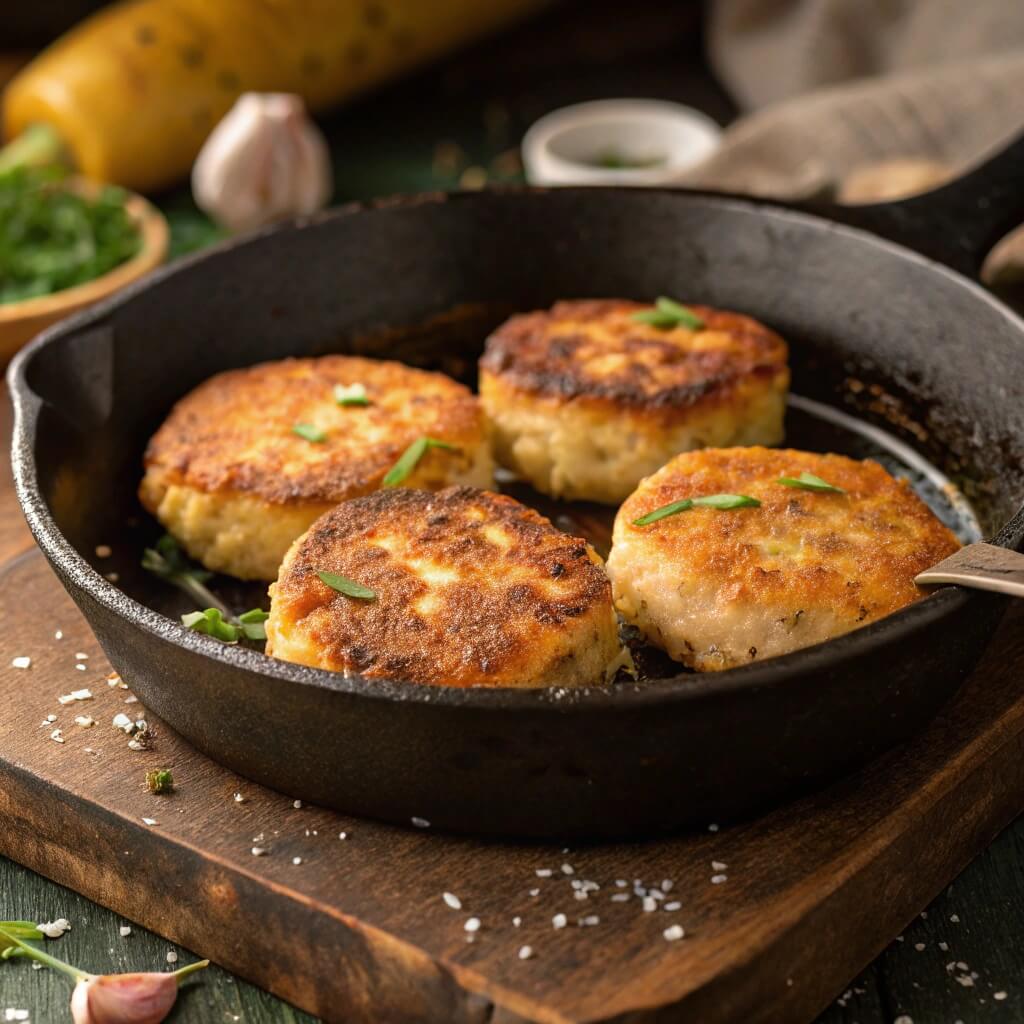Have you ever tasted a bread that’s both simple and satisfying? A bread that tells a story with every bite? That’s mchadi for you. This isn’t your everyday loaf. Mchadi is a traditional Georgian cornbread that holds a special place at the Georgian table. Think of it as the reliable friend at every meal, always there and always good. You might find it served alongside hearty stews, flavorful meat dishes, or even just with a dollop of honey. It’s a staple, a comfort food, and a delicious way to experience Georgian culture.
Ever wonder what makes this bread so unique? Or how such few ingredients can create such an excellent taste and texture? Perhaps you’re curious about how to make it in your kitchen, bringing a little piece of Georgia to your home. You’re in the right place. We’ll walk through everything you need to know to bake your very own mchadi.
What Exactly is Mchadi?
Mchadi is a flatbread made primarily from cornmeal. It’s a simple bread, often unleavened, meaning it doesn’t use yeast or baking powder to rise significantly. This results in a dense yet slightly crumbly texture, with a distinct corn flavor that is both earthy and subtly sweet. It’s a bread that speaks of tradition, often made in homes across Georgia with recipes passed down through generations.
This cornbread is more than just a side dish; it’s a culinary delight. It’s an integral part of the Georgian culinary landscape. You’ll see it on the table during family dinners, at festive gatherings, and in restaurants across the nation. Its simplicity allows it to complement a wide variety of flavors, making it a versatile and beloved part of Georgian cuisine.
Simple Ingredients for Delicious Mchadi
The beauty of mchadi lies in its short list of ingredients. You don’t need a pantry full of exotic items to create this flavorful bread. The main ingredient is cornmeal. Not just any cornmeal, though. In Georgia, they often use coarsely ground white or yellow cornmeal, which gives mchadi its characteristic texture.
The other essential ingredient is water. That’s often it! Just cornmeal and water come together to form the dough. Sometimes, a small amount of salt is added to enhance the flavor. In some regional variations, you might find a touch of oil or even cheese incorporated into the dough, but the classic mchadi recipe remains wonderfully simple. These basic ingredients, when combined with the proper technique, transform into a satisfying and flavorful bread.
Your Step-by-Step Guide to Baking Perfect Mchadi
Making mchadi might seem straightforward, and in many ways, it is. However, like any good recipe, a few key steps and tips can make all the difference between a good mchadi and a truly excellent one. Let’s break down the process.
Preparing the Dough
The first step is to combine your cornmeal and water. The ratio is important here. You generally want a dough that holds together but isn’t too sticky. Start by placing the cornmeal in a bowl and gradually adding warm water. Knead the dough with your hands until a shaggy mass forms. You should be able to gather it into a ball. The amount of water might vary slightly depending on the type of cornmeal you use, so add it little by little until you reach the right consistency.
Once the dough comes together, knead it gently for a few minutes. This isn’t like kneading wheat dough; you’re not developing gluten in this process. Instead, you’re ensuring that the cornmeal is evenly hydrated and the dough is smooth. It should feel firm and pliable. If the dough is too dry, add a small amount of water to moisten it. If it’s too sticky, add a little more cornmeal. The goal is a dough that you can easily shape with your hands. Let the dough rest for about 10-15 minutes before shaping. This allows the cornmeal to absorb the water thoroughly.
Shaping and Baking
Now comes the shaping. Traditionally, mchadi is shaped into small, round or oval patties, about ½ to ¾ inch thick. Take a handful of dough and gently flatten it between your palms. Aim for a uniform thickness so that the mchadi cooks evenly. You can make them any size you like, but smaller ones tend to cook faster.
The traditional way to cook mchadi is in a ketsi, a shallow clay pan, often placed over an open fire or on a stovetop. If you don’t have a ketsi, a cast-iron skillet or a non-stick pan works perfectly well. Heat your pan over medium heat. There’s no need to add any oil to the pan at this stage, as mchadi is typically baked dry. Once the pan is hot, carefully place the mchadi patties in the pan. Cook them for about 5-7 minutes on each side, or until they are golden brown and slightly crispy on the outside. You may notice some darker spots, which contribute to the flavor.
Tips for the Best Mchadi
- Use good quality cornmeal: The flavor of your mchadi will largely depend on the cornmeal you use. Opt for a coarsely ground cornmeal for a more authentic texture.
- Don’t overwork the dough: Unlike wheat dough, over-kneading cornmeal dough can make it tough and rubbery. Mix it just until it comes together.
- Control the heat: Cook the mchadi over medium heat to ensure it cooks through without burning on the outside.
- Listen to your mchadi: You’ll know it’s ready when it sounds slightly hollow when tapped and is nicely browned on both sides.
- Serve it fresh: Mchadi is best enjoyed warm, straight from the pan.
Serving Suggestions: Enjoying Your Freshly Baked Mchadi
Mchadi’s simple flavor makes it a fantastic accompaniment to a wide array of dishes. In Georgia, you’ll often find it served with lobio (a kidney bean stew), kharcho (a flavorful meat and rice soup), or grilled meats, such as mtsvadi (a type of shish kebab). Its slightly coarse texture is perfect for soaking up the delicious sauces and juices from these dishes.
Beyond savory pairings, mchadi can also be enjoyed with more straightforward accompaniments. A dollop of honey or a piece of salty cheese offers a delightful contrast to the earthy corn flavor. Some people also enjoy it with tkemali, a tart plum sauce that is another staple of Georgian cuisine.
Don’t be afraid to experiment with your pairings. Mchadi’s versatility means it can fit into many different meals. Think of it as a blank canvas that complements intense flavors. Whether you’re having a hearty stew or a simple salad, mchadi can be an excellent addition to your table.
Mchadi: More Than Just Bread
Mchadi holds a cultural significance that goes beyond its role as a food item. It’s a symbol of Georgian hospitality and tradition. The act of making and sharing mchadi is often a communal one, with family members participating in the process. It connects generations, with grandmothers passing down their well-guarded recipes to younger family members.
The simplicity of its ingredients also speaks to the resourcefulness of Georgian cooking. Corn was and remains a readily available grain in many regions of Georgia, making mchadi an accessible and affordable staple. It’s a testament to how delicious and satisfying a dish can be even with just a few basic components.
Furthermore, mchadi’s regional variations showcase the diversity within Georgian cuisine. While the basic recipe of cornmeal and water remains consistent, different areas might add their twist, such as incorporating cheese or using various types of cornmeal. This regional diversity adds another layer of richness to the story of Mchadi.
Mchadi is more than just a simple cornbread. It’s a taste of Georgia, a culinary tradition that embodies simplicity, flavor, and cultural significance. From its humble ingredients to its satisfying taste and its place at the Georgian table, mchadi offers a unique and delicious experience.
Now you know how to bring this taste of Georgia into your kitchen. With just a few ingredients and a little bit of your time, you can create a mchadi that will complement your meals and perhaps even spark conversations about this fascinating culinary tradition. So, go ahead, try baking mchadi. Enjoy the process, savor the aroma, and most importantly, relish the taste of this excellent Georgian bread.











